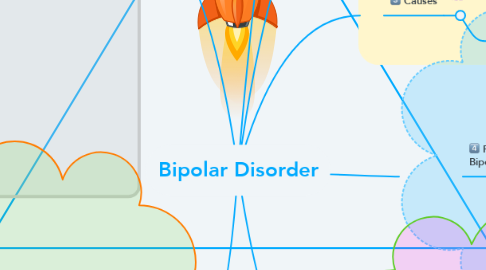
1. Nurses Roles
1.1. understanding the complexity and recurrent nature of this brain disorder
1.2. assist patient in interpreting situations objectively
1.3. provide a safe environment for client
1.4. Decreasing environmental stimulation may assist client to relax
1.5. nurse uses simple, clear sentences when communicating
1.6. Ask assess the patient about suicidal thoughts. A nurse must establish external controls emphatically and nonjudgementally.
1.7. Encourage psychoeducational interventions and personal journals describing mood changes and behavior
1.8. Encourage peer support groups and/or family-to family education.
1.9. Assist in meeting the physiological needs, eg. nutrition, proper sleep
2. Risk Factors Contributing to Poor Physical Health in a Bipolar Disorder
2.1. Health Habits
2.1.1. • Poor diet • Inadequate exercise • Irregular sleep patterns • Smoking • Chronic stress responses • Substance use
2.2. Health Care Access and Utilization
2.2.1. • Social factors -isolation, homelessness, lack of insurance • Lack of access to preventive healthcare or a “medical home” • Medication side effects used for treatment • Feeling stigmatized as a person with a mental disorder
3. Causes
3.1. Genetics, impact of childhood adverse events, stressful life situation, misdiagnosis, brain variations, physiological, medication side effectsetc.
4. Recognition and Diagnosis of Bipolar Disorder
4.1. initial diagnoses may be inaccurate because patients tend to seek treatment when depressed not manic.
4.2. • Complete physical exam • A comprehensive medical history • Screening for depression to differentiate unipolar from bipolar depression .
5. Treatment for Bipolar Disorder
5.1. Medication
5.1.1. mood stabilizers
5.1.2. Antipsychotics and Atypical Antipsychotics
5.1.3. Antidepressants
5.2. Supplemental psychotherapies
5.2.1. Psychosocial Education (PE) X
5.2.2. Interpersonal Social Rhythm Therapy (IPSRT)
5.2.3. Family-Focused Therapy (FFT), Cognitive Behavioral Therapy (CBT)
6. Types
6.1. Bipolar type 1
6.1.1. Mania is the “high” side of bipolar 1 disorder.
6.1.2. a full syndrome of of manic or mixed symptoms; the client may also have experienced periods of depression.
6.2. Bipolar Type 2
6.2.1. recurrent bouts of major depression with the episodic occurrence of hypomania
6.2.2. this individual has never experienced a full syndrome of manic or mixed symptoms
